|
|
|
Sort Order |
|
|
|
Items / Page
|
|
|
|
|
|
|
| Srl | Item |
| 1 |
ID:
140307
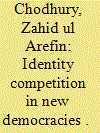

|
|
|
|
|
| Summary/Abstract |
Literature on the role of social cleavages in stabilising democratic politics shows that during the initial period of democratisation voters tend to get cues from their core identities, and thus vote along identity lines. As a result, in multicultural societies ethnic parties emerge to take part in elections. But the literature does not indicate how identities compete with each other. Particularly, which (source of) identity – among a possible range of identities such as ethnicity, language, race and religion – does a better job in stabilising democracies? This comparative study combines analyses of cross-country fractionalisation, political volatility and World Value Surveys data with case studies of four Muslim majority countries – Turkey, Pakistan, Nigeria and Bangladesh – to demonstrate that non-religious identities stabilise democracies during the initial period of democratisation, while the religious identity (Islam) gradually trumps others as the political system stabilises over time.
|
|
|
|
|
|
|
|
|
|
|
|
|
|
|
|
| 2 |
ID:
140304
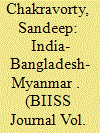

|
|
|
|
|
| Summary/Abstract |
Many sub-regional initiatives are prospering in Asia. As the limits to regional cooperation become evident, particularly in the SAARC context, sub-regional cooperation offers a window of opportunity for India to push through economic integration of India with its South and South East Asian neighbours. Already some examples exist which need to be emulated and expanded upon such as ADB‘s SASEC programme for some South Asian countries or BIMSTEC involving South and South East Asia. This paper spells out the need and rationale for energising sub-regional cooperation among three major countries straddling the South and South East Asia axis namely India, Bangladesh and Myanmar. It argues that there is sufficient content and context in the three bilateral relationships, which of late have been witnessing upswings, to start working on various trilateral cooperation proposals. This will not only be a win-win formula for all three countries involved but will also propel greater cooperation in some other larger configurations of sub-regional cooperation namely BIMSTEC or BCIM-EC as these three countries form the geographical kernel of other frameworks as well.
|
|
|
|
|
|
|
|
|
|
|
|
|
|
|
|
| 3 |
ID:
140303
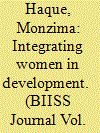

|
|
|
|
|
| Summary/Abstract |
The global movement for the recognition of women’s rights as human rights attempted to identify those rights crucial to the well being of women. The Universal Declaration of Human Rights (1948) and other subsequent assertion of equal rights to men and women in spite of their sexual identity are very crucial in this regard. Conventional wisdom suggests that the progress towards equality for men and women has not been satisfactory in developing countries like Bangladesh where women are subject to exclusion as a result of the ‘socialeconomic-political’ as well as ideological privileges of men evident in the patriarchal structure of the society. The paper argues that although women’s presence and participation in the development process of Bangladesh have not been adequate, the initiatives at various levels to address this inadequacy and progressive movements of women in diverse sectors of Bangladesh have brought in a number of affirmative changes. With this aim, the paper attempts to review the current status of women in the political, economic and social development of the country and examines the strengths and limitations of integration of women in mainstream development structure.
|
|
|
|
|
|
|
|
|
|
|
|
|
|
|
|
| 4 |
ID:
140306
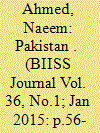

|
|
|
|
|
| Summary/Abstract |
This paper critically examines the counterterrorism strategy of Pakistan, which it adopted after the 9/11 incident, by arguing that so far, it has proved ineffective and counter-productive in uprooting the terrorist network of Pakistan-based militant Jihadi and extremist groups that also have links with Al-Qaeda. In this respect, the paper, besides defining and assessing Pakistan’s counterterrorism strategy, also analyses various factors which have contributed to the inefficacy of the country’s counterterrorism strategy. In the concluding analysis, the paper emphasises upon the need for formulating an effective counterterrorism strategy of Pakistan.
|
|
|
|
|
|
|
|
|
|
|
|
|
|
|
|
| 5 |
ID:
140305
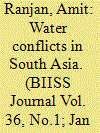

|
|
|
|
|
| Summary/Abstract |
Water conflict in South Asia is one of the critical challenges for the region. The unitary irrigation system constructed since Mughal period was divided in 1947, when the sub-continent was partitioned into India and Pakistan. Not enthusiastic to break the then existing hydrological, railway and port systems, Sir Cyril Radcliffe took ‘other factors’ also into consideration and not only religion as a sole determinant to partition the sub-continent. Despite his efforts, the water bodies were divided between the two arch enemies. Soon after the partition, the conflicts over shared water bodies started and have been graduated over the decades. The political animosities among the South Asian neighbours have inflamed the water conflicts further. As a result, arrangements, agreements and treaties seeking cooperation over shared water resources have failed to address water related grievances of each country. One common allegation the neighbouring countries have is that India exploits their resources for its own use. This allegation helps the radical elements from those countries to espouse the causes and raise the cries of water nationalism. Not only in those countries, the feeling of ‘sovereign’ rivers is also strong in India. The political tensions over water are duly aided by the growing supply-demand gap, phenomenon of climate change and predominant use of supply-side management system. Though the water conflicts are bilateral, it has regional implications. Realising this fact, in most of the regions, the regional organisations have taken steps to mitigate differences among the riparian states and have helped them to enter into a cooperative arrangement. In South Asia, this is difficult to attain because the South Asia Association for Regional Cooperation (SAARC) is not a very effective body.
|
|
|
|
|
|
|
|
|
|
|
|
|
|
|
|
|
|
|
|
|